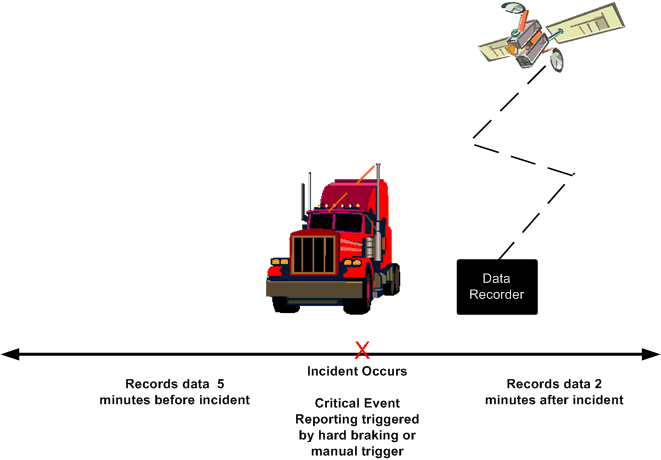Critical Event Reporting (CER) provides alert notification of unsafe driving patterns when a vehicle is on the road. Fleet managers receive alerts in near real-time via email. From the alert email they can link to the CER application where they can see more detailed information about the incident that triggered the alert.
Based on this information, the manager may choose to contact the driver immediately, schedule a coaching session, or take other action to improve operations and help limit future liability.
What triggers a Critical Event Report?
Critical Event Reports are triggered by on-board sensors that monitor variables such as vehicle speed and stability, or by the driver who can initiate a manual event using the mobile terminal. CER triggers include:
- Hard braking: triggered by sudden deceleration as detected by sensors built into the vehicle
- Stability control: triggered by anti-rollover sensors provided by a third-party vendor
- Lane Departure Warning (LDW): triggered when vehicle departs the lane too many times within a given time period without using the turn signal. Requires a third-party sensor to detect lane changes.
- Forward Collision Warning (FCW): triggered when a third-party collision warning system alerts that a forward collision is imminent
- Following-time Violation (FTV): triggered when a third-party collision warning system calculates that the vehicle is following too closely behind the vehicle in front of it.
- Manual: triggered when the driver pushes the appropriate key sequence or taps the appropriate buttons on the driver interface unit (DU, DIU, MDU, etc).
Every vehicle with CER has hard braking and manual triggers. Other triggers depend on the vehicles being equipped with third-party sensors
How does CER work?
Critical Event Reporting (CER) captures data from sensors via either the J1708 or J1939 data bus.
CER constantly records information from the vehicle's sensors, but if no critical event occurs, older information is erased to make room for newer information. When a critical event occurs, the system saves the information for the five minutes previous to the incident. CER continues recording during the incident and for two minutes after the incident.
When recording finishes, CER automatically sends the information over the air to the Omnitracs network operations center (NOC). The CER service sends out email alerts to the designated recipients and provides detailed reports for analysis.
